Investigation into the Influence of Stress Conditions on the Permeability Characteristics of Weakly Cemented Sandstone
Abstract
:1. Introduction
2. Materials and Methods
2.1. Water Softening Test of Rock
2.2. Permeability Measuring Instrument
2.3. Estimation of Rock Deformation Parameters
3. Test Results and Analysis
3.1. Seepage Result of Weakly Consolidated Sandstone
- (a)
- Stage of Steady Permeability Decrease: During the initial loading phase, as the deviatoric stress increases, permeability gradually decreases. In this stage, the internal rock pores are compacted, pore sizes reduce, and the fluid’s ability to flow weakens, resulting in reduced permeability. The fundamental reason for the early decrease in permeability is the compaction of weakly cemented rock’s internal porosity and the reduction in pore size during triaxial compression.
- (b)
- Stage of Rapid Permeability Increase: In this stage, the rock undergoes stress-induced failure, reaching its peak strength. Primary cracks widen, secondary cracks significantly extend, and they become interconnected, leading to a substantial increase in permeability.
- (c)
- Stage of Equilibrium Permeability: When the axial stress on the rock specimen reaches a certain level, the changes in internal cracks become less pronounced, and permeability tends to stabilize. The evolution of permeability in weakly cemented sandstone samples exhibits distinct stages, which are crucial for understanding the rock’s response to stress and its impact on fluid flow behavior.
3.2. Seepage Model Building Scheme
Permeability Calculation Method
3.3. Comparative Analysis of Experiment and Numerical Simulation
3.4. Permeability Variation under Different Stress States
4. Discussion
4.1. Joint and Pore Size Development Characteristics
4.2. Effect of Stress State on Hydraulic Openness and Permeability
4.3. Study on Damage Regularity of Weakly Consolidated Sandstone
5. Conclusions
- (1)
- After being saturated with water, weakly cemented sandstone experiences a significant reduction in uniaxial compressive strength, accompanied by a transition from brittle to plastic failure. The stress–strain curves from numerical simulations closely matched the experimental results. The use of the Hoek—Brown method for estimating rock deformation parameters ensured the accuracy of subsequent permeability simulations.
- (2)
- Indoor permeability experiments revealed a distinctive pattern in the permeability curve of weakly cemented sandstone, which differed from conventional sandstone. The permeability curve exhibited a trend resembling a “√,” characterized by an initial gradual reduction, followed by an increase, and eventual stabilization. The stress–strain curve did not exhibit a stress-drop phase after reaching peak strength. The numerical simulation results showed excellent agreement with the experimental outcomes. Subsequently, simulations of permeability curves under varying confining pressures were conducted, revealing a trend of initial reduction followed by an increase, providing a foundational basis for the development and analysis of numerical models related to weakly cemented strata.
- (3)
- An analysis of the causes of changes in permeability from a pore perspective indicated that confining pressure restricted the expansion of micro-cracks in the rock. Pore pressure prompted the development of fractures, starting in high-pressure areas and extending to low-pressure areas. Permeability gradually increased with rising pore pressure, while increased confining pressure led to a decrease and subsequent increase in permeability for weakly cemented sandstone. Axial compression initially reduced permeability before gradually increasing it. In numerical simulations, the value of normal stiffness showed a negative correlation with permeability before stabilizing.
- (4)
- Using programming to monitor the quantity of fissures during the compression numerical simulation, a damage parameter ‘D’ was introduced, refining the expression of the damage parameter. It was observed that, with increasing confining pressure, the damage parameter initially decreased and then rapidly increased. Additionally, the magnitude of the hydraulic pressure differential exhibited a direct proportional correlation with the damage parameter.
Author Contributions
Funding
Institutional Review Board Statement
Informed Consent Statement
Data Availability Statement
Acknowledgments
Conflicts of Interest
References
- Zhao, W.S.; Liang, W. Influence of formation water content on the stability of surrounding rock of weakly consolidated soft rock roadway: A case study of Wujianfang Xiyi Coal Mine in Inner Mongolia. China Min. Ind. 2019, 29, 154–159. [Google Scholar] [CrossRef]
- Li, T.C.; Lu, Z. Analysis of deformation and failure process of rectangular roadway in muddy weakly cemented soft rock formation. Rock Soil Mech. 2014, 35, 1077–1083. [Google Scholar] [CrossRef]
- Liang, J.; Wang, Q. Experimental study on mechanics and permeability characteristics of Jurassic red sandstone under seepage-stress coupling. Bull. Geol. Sci. Technol. 2023, 42, 52–61. [Google Scholar] [CrossRef]
- Hashemnejad, A.; Aghda, S.M.F. Introducing a new classification of soft rocks based on the main geological and engineering aspects. Bull. Eng. Geol. Environ. 2021, 80, 4235–4254. [Google Scholar] [CrossRef]
- Qin, L.; Sun, Y.J. Experimental Study on Seepage Characteristics of Jurassic Weakly Cemented Sandstone under Water-Rock Interaction. Geofluids 2020, 2020, 8543687. [Google Scholar] [CrossRef]
- Baghbanan, A.; Jing, L. Hydraulic properties of fractured rock masses with correlated fracture length and aperture. Int. J. Rock Mech. Min. 2007, 44, 704–719. [Google Scholar] [CrossRef]
- Li, X.; Xu, Q.; Chen, S. An experimental and numerical study on water permeability of concrete. Constr. Build Mater. 2016, 105, 503–510. [Google Scholar] [CrossRef]
- Indraratna, B. Hydromechanical aspects of jointed rock media. In Proceedings of the 8th ISRM Congress, Tokyo, Japan, 25 September 1995; International Society for Rock Mechanics: Lisbon, Portugal, 1995. [Google Scholar]
- Jing, L.; Ma, Y.; Fang, Z. Modeling of fluid flow and solid deformation for fractured rocks with discontinuous deformation analysis (DDA) method. Int. J. Rock Mech. Min. 2001, 38, 343–355. [Google Scholar] [CrossRef]
- Kim, Y.I.; Amadei, B.; Pan, E. Modeling the effect of water, excavation sequence and rock reinforcement with discontinuous deformation analysis. Int. J. Rock Mech. Min. 1999, 36, 949–970. [Google Scholar] [CrossRef]
- Geng, J.; Cao, L. Failure analysis of water-bearing sandstone using acoustic emission and energy dissipation. Eng. Fract. Mech. 2020, 231, 107021. [Google Scholar] [CrossRef]
- Wang, H.; Li, J.; Guo, Q.; Shi, R.; Zhao, Z.; Zhang, Y.; Zhao, F. Experimental study on the influence of water on the failure properties of sandstone. Bull. Eng. Geol. Environ. 2021, 80, 7747–7771. [Google Scholar] [CrossRef]
- Zhang, H.; Lu, K.; Zhang, W.; Zhou, Y.; Yang, G.; Li, J.; Huang, C. A comprehensive study of damage characteristics and acoustic emission response mechanism of sandstone with different water contents. Eng. Fract. Mech. 2023, 109392. [Google Scholar] [CrossRef]
- Chen, G.; Li, T.; Wang, W.; Zhu, Z.; Chen, Z.; Tang, O. Weakening effects of the presence of water on the brittleness of hard sandstone. Bull. Eng. Geol. Environ. 2019, 78, 1471–1483. [Google Scholar] [CrossRef]
- Liu, W.; Yang, K.; Zhang, S.; Zhang, Z.; Xu, R. Energy evolution and water immersion-induced weakening in sandstone roof of coal mines. Int. J. Coal Sci. Technol. 2022, 9, 53. [Google Scholar] [CrossRef]
- Wang, S.; Han, L. Water absorption/dehydration by NMR and mechanical response for weakly cemented mudstones subjected to different humidity conditions. Bull. Eng. Geol. Environ. 2020, 79, 1275–1288. [Google Scholar] [CrossRef]
- Zhang, J.F.; Cheng, S.F. Mesostructure and hydraulic characteristics of weakly cemented soft rock in western China. Coal Geol. Explor. 2020, 48, 116–121. [Google Scholar] [CrossRef]
- Liu, H.L. Study on water-retaining mining mechanism and classification of extra thick coal seam in Yili weak cementation formation. China Univ. Min. Technol. 2020. [Google Scholar] [CrossRef]
- Yang, J.H.; YE, Z.Y. Study on coupling model of single fracture seepage and normal stress of rock mass considering soft and hard body opening. Chin. J. Rock Mech. Eng. 2023, 42, 3473–3480. [Google Scholar] [CrossRef]
- Wang, H. Numerical Simulation of Fractured Rock Failure Process and Related Laws. Anhui University of Science and Technology. 2015. Available online: https://kns.cnki.net/KCMS/detail/detail.aspx?dbname=CMFD201502&filename=1015563274.nh (accessed on 6 June 2015).
- Hou, X.G. Study on Mechanical and Acoustic Emission Characteristics of Weakly Cemented Sandstone Under Uniaxial Compression. Northeastern University. 2014. Available online: https://kns.cnki.net/KCMS/detail/detail.aspx?dbname=CMFD201602&filename=1016013881.nh (accessed on 10 June 2014).
- Jia, C.; Xu, W.; Wang, H.; Wang, W.; Yu, J.; Lin, Z. Laboratory investigations of inert gas flow behaviors in compact sandstone. Environ. Earth Sci. 2018, 77, 245. [Google Scholar] [CrossRef]
- Zhang, S.Z. Evolution Law and Control Mechanism of Dynamic Water Resistance Performance of Weakly Cemented Formation in Yili Mining Area. Ph.D. Thesis, China University of Mining and Technology, Jiangsu, China. Available online: https://kns.cnki.net/KCMS/detail/detail.aspx?dbname=CDFDLAST2022&filename=1021773652.nh (accessed on 1 May 2021).
- Yang, T. Research on Permeability Properties and Coupling Effects of Rock Rupture Process and Stress. Ph.D. Thesis, Northeastern University, Liaoning, China. Available online: https://kns.cnki.net/KCMS/detail/detail.aspx?dbname=CDFD9908&filename=2006157861.nh (accessed on 11 August 2023).
- Itasca. The Universal Distinct Element Code (UDEC), Version 7.0; Itasca Consulting Group Inc.: Minneapolis, MN, USA, 2014.
- Gao, F.Q.; Stead, D. The application of a modified Voronoi logic to brittle fracture modelling at the laboratory and field scale. Int. J. Rock Mech. Min. Sci. 2014, 68, 1–14. [Google Scholar] [CrossRef]
- Min, K.-B.; Rutqvist, J.; Tsang, C.-F.; Jing, L. Stress-dependent permeability of fractured rock masses: A numerical study. Int. J. Rock Mech. Min. Sci. 2004, 41, 1191–1210. [Google Scholar] [CrossRef]
- Zhang, S.; Zhang, D.; Wang, Z.; Chen, M. Influence of Stress and Water Pressure on the Permeability of Fissured Sandstone Under Hydromechanical Coupling. Mine Water Environ. 2018, 37, 774–785. [Google Scholar] [CrossRef]
- Zhang, Y. Study on the Seepage Law and Water Penetration Mechanism of Fissure Rock Mass under Water-Force Coupling. Ph.D. Thesis, University of Science and Technology Beijing, Beijing, China. Available online: https://kns.cnki.net/KCMS/detail/detail.aspx?dbname=CDFDLAST2021&filename=1021001403.nh (accessed on 25 December 2020).
- Li, L.; Zhang, C.; Wang, W. A modified Hoek-Brown failure criterion for anisotropic rock mass. Yanshilixue Yu Gongcheng Xuebao/Chin. J. Rock Mech. Eng. 2018, 37, 3239–3246. [Google Scholar] [CrossRef]
- Saroglou, H.; Tsiambaos, G. A modified Hoek-Brown failure criterion for anisotropic intact rock. Int. J. Rock Mech. Min. Sci. 2008, 45, 223–234. [Google Scholar] [CrossRef]
- Cammarata, G.; Fidelibus, C.; Cravero, M.; Barla, G. The hydro mechanically coupled response of rock fractures. Rock Mech. Rock Eng. 2007, 40, 41–61. [Google Scholar] [CrossRef]
- Farahmand, K.; Diederichs, M.S. Calibration of coupled hydro-mechanical properties of grain-based model for simulating fracture process and associated pore pressure evolution in excavation damage zone around deep tunnels. J. Rock Mech. Geotech. Eng. 2021, 13, 60–83. [Google Scholar] [CrossRef]
- Zhang, C.; Tu, S.; Zhang, L. A Study on Effect of Seepage Direction on Permeability Stress Test. Arab. J. Sci. Eng. 2016, 41, 4583–4596. [Google Scholar] [CrossRef]
- Worthington, P.F. A diagnostic approach to quantifying the stress sensitivity of permeability. J. Pet. Sci. Eng. 2008, 61, 49–57. [Google Scholar] [CrossRef]
- Zhang, K.; Guo, J.; Teng, T. Experimental study on the characteristics of water injection softening and seepage of weakly cemented sandy mudstone—Take Shendong mining area as an example. Coal Sci. Technol. 2022, 50, 195–201. [Google Scholar] [CrossRef]
- Liu, W.; Du, Y.; Yu, J.; Yin, D.; Xu, H.; He, R.; Men, X. Experimental study on compressive seepage characteristics and acoustic emission characteristics of subsidence column skeleton sandstone. J. Rock Mech. Eng. 2021, 40, 1580–1590. [Google Scholar] [CrossRef]

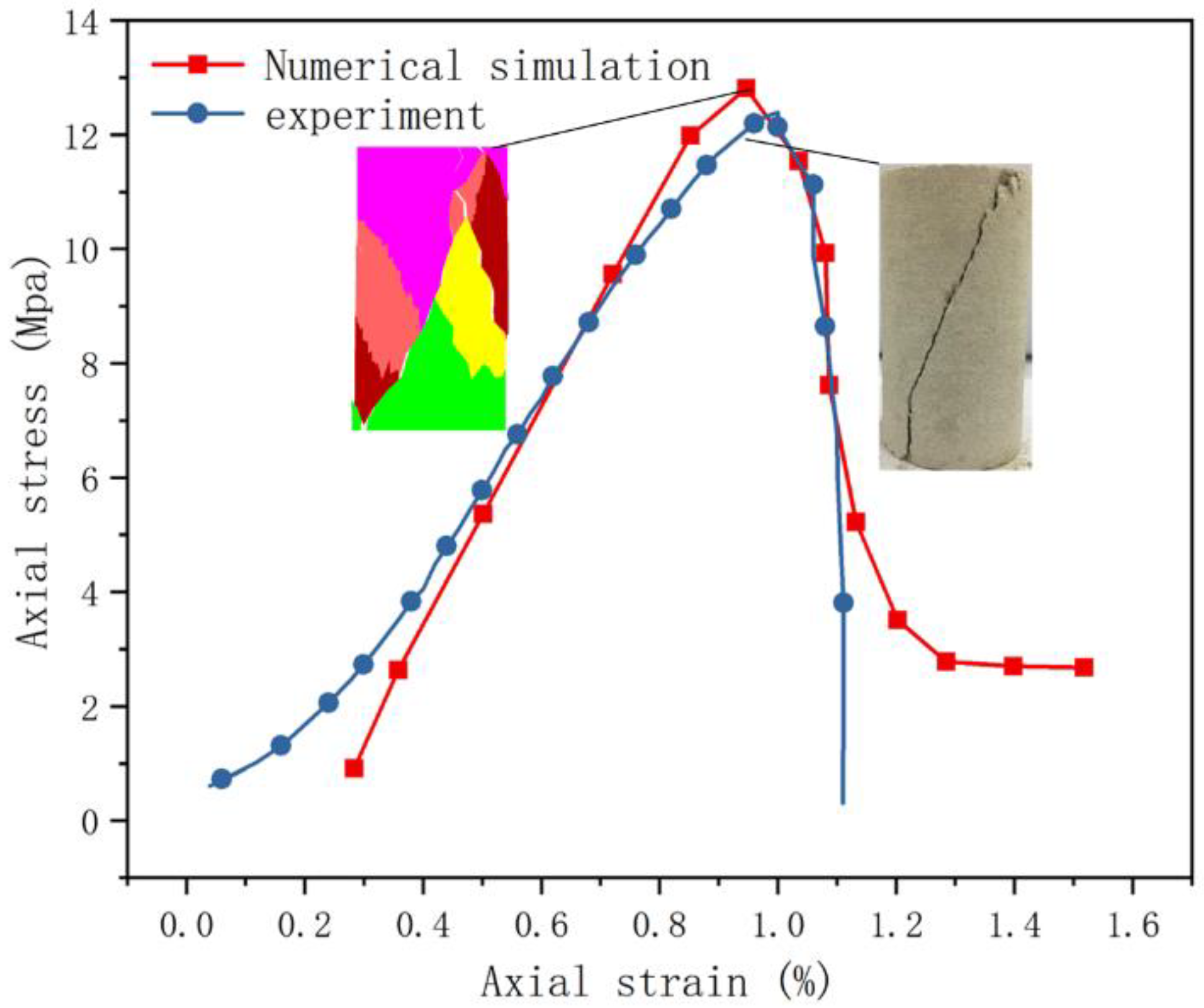

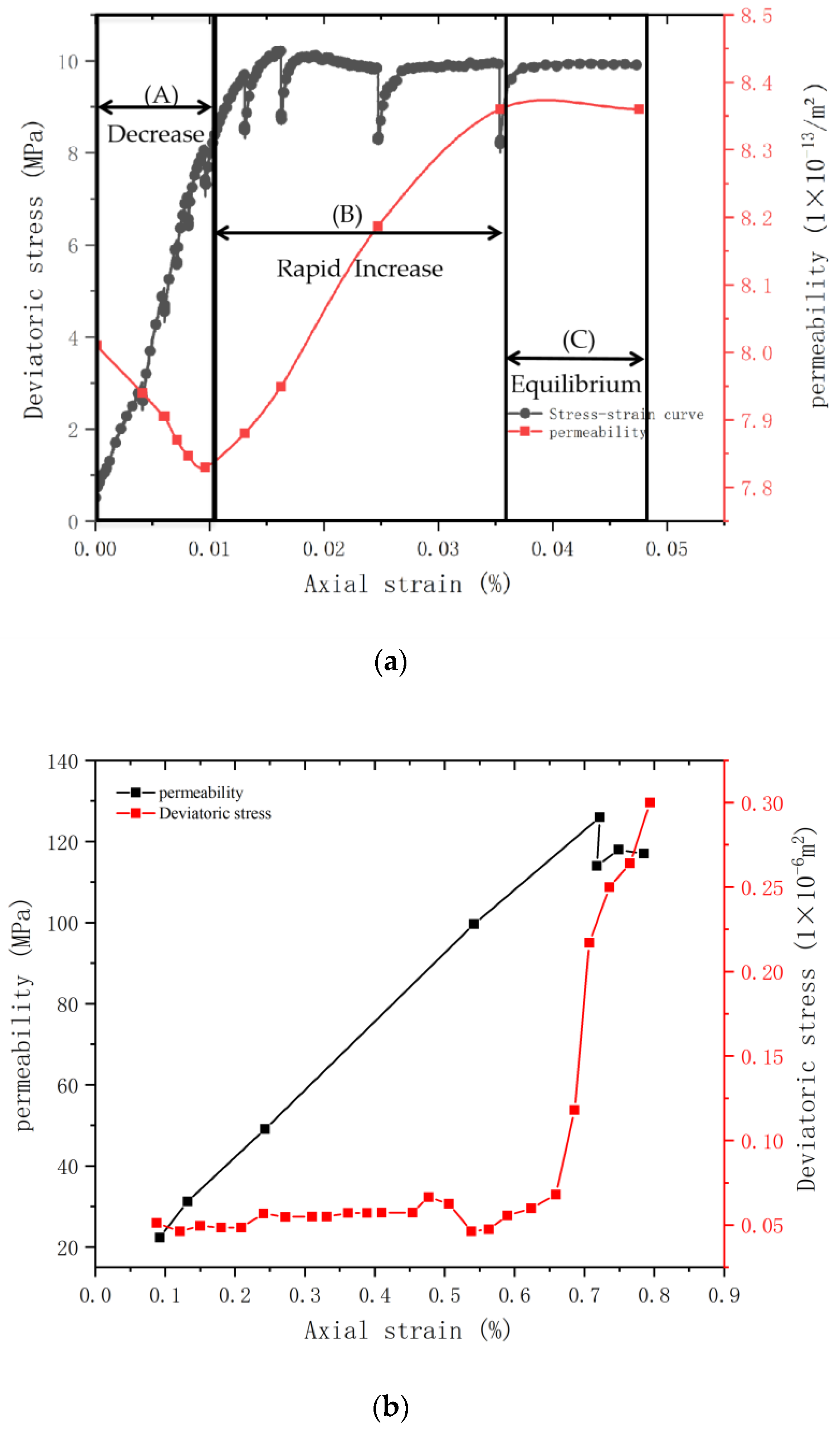

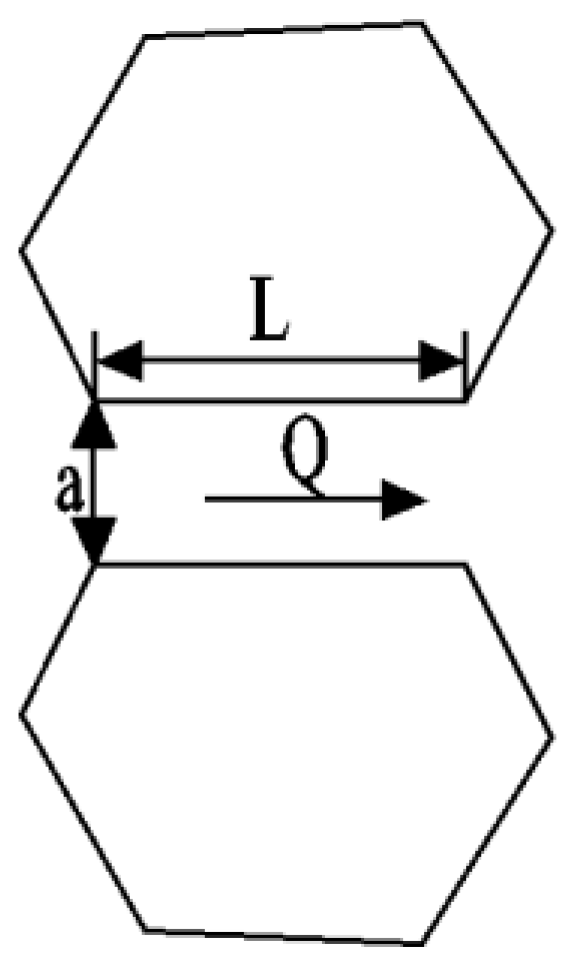
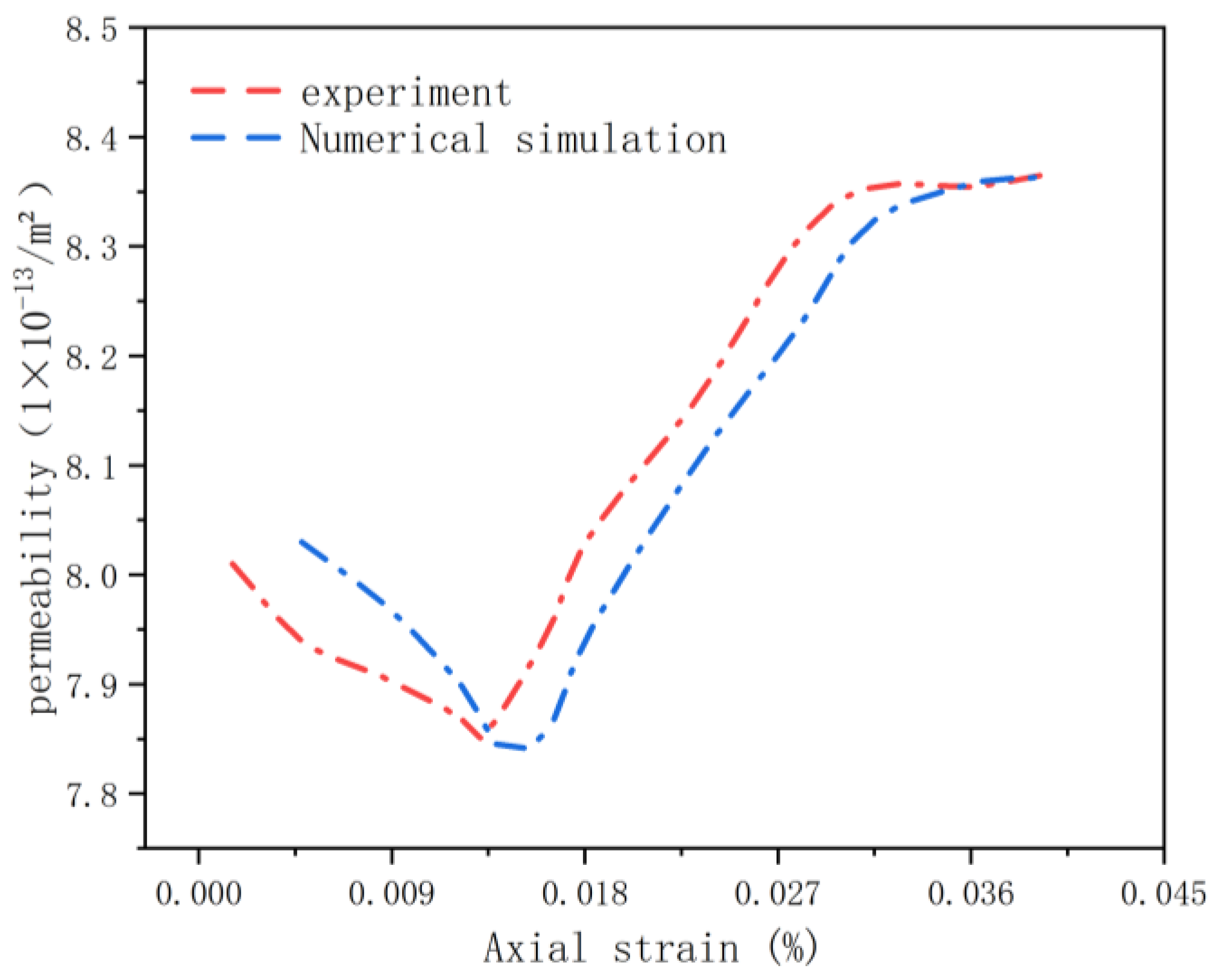

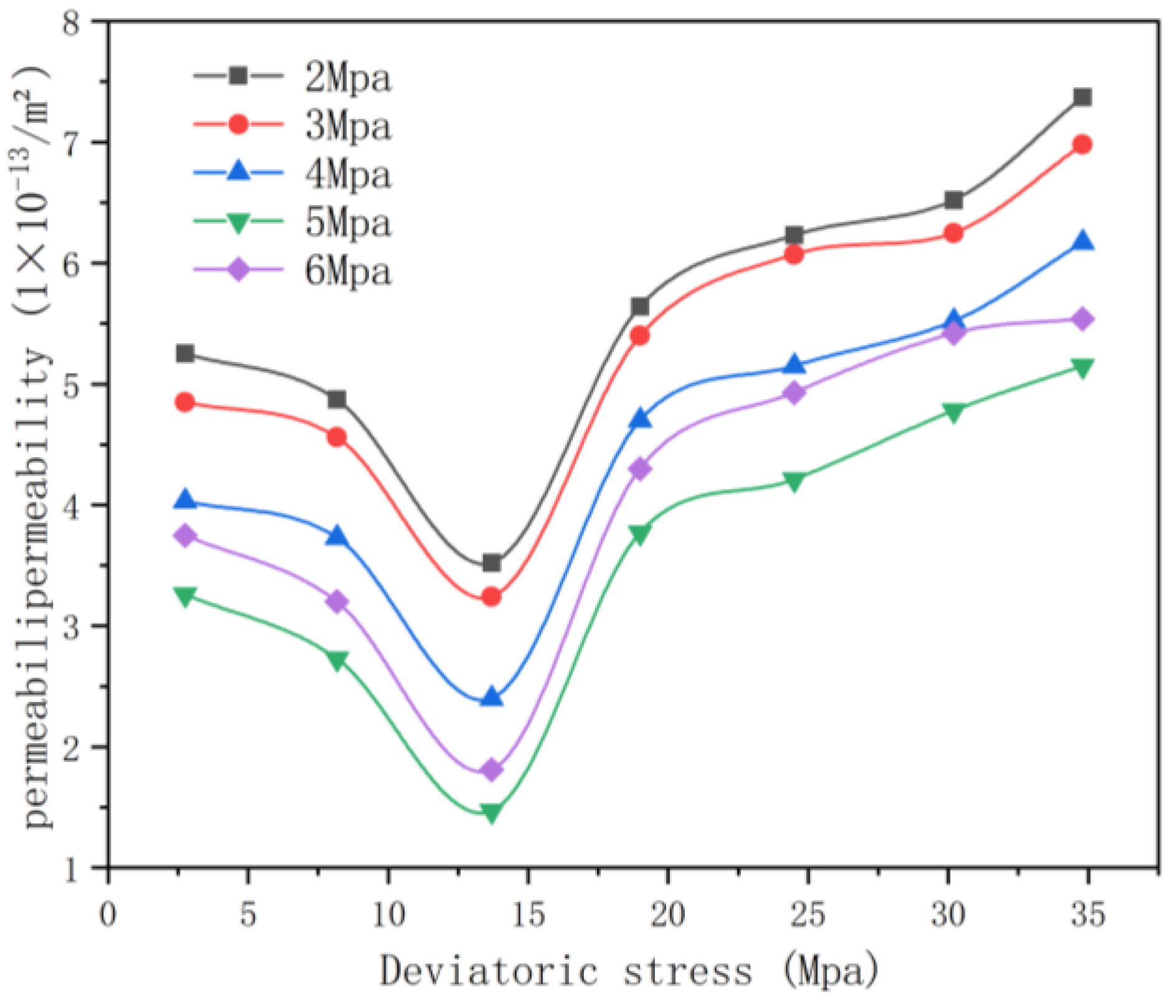


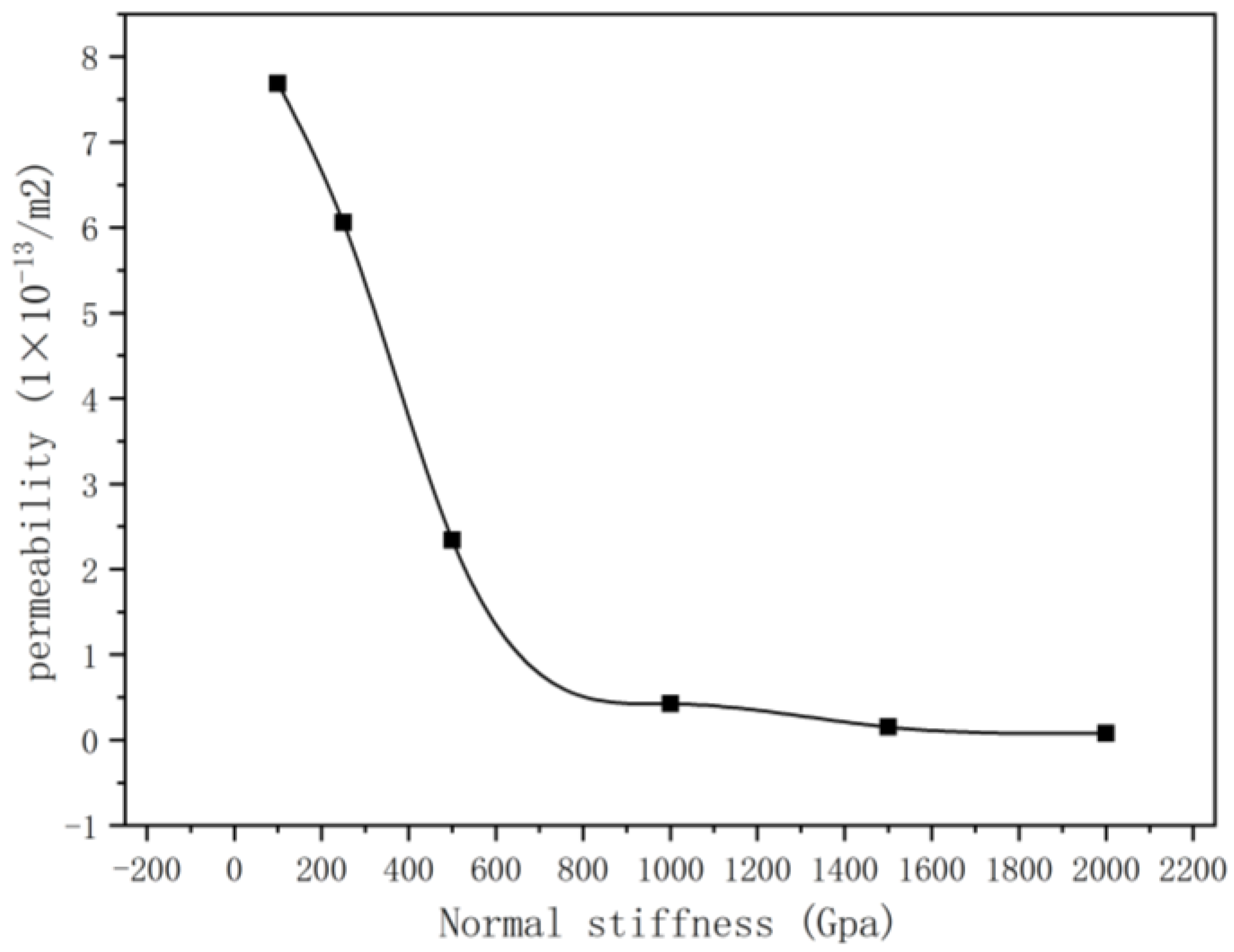

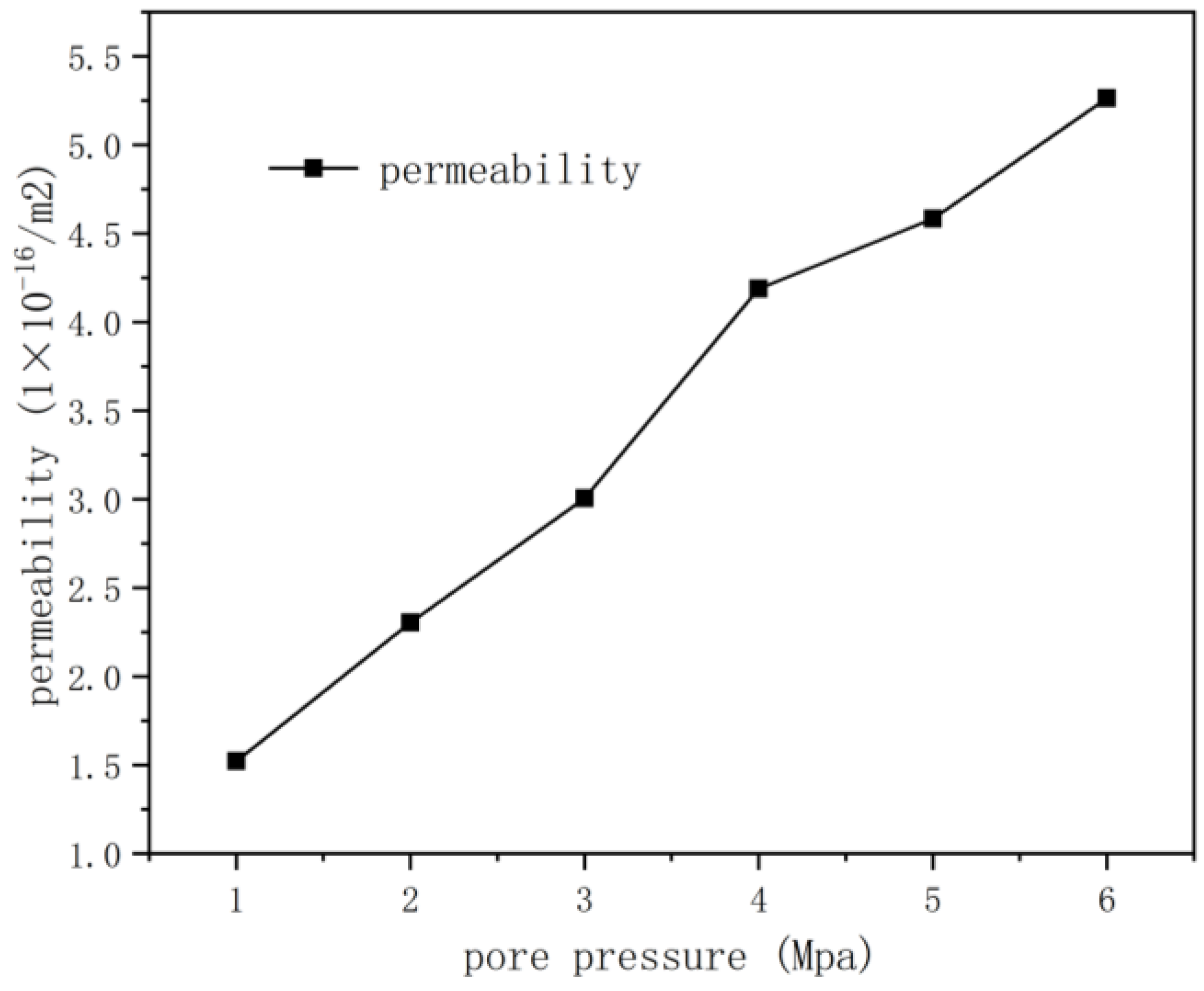
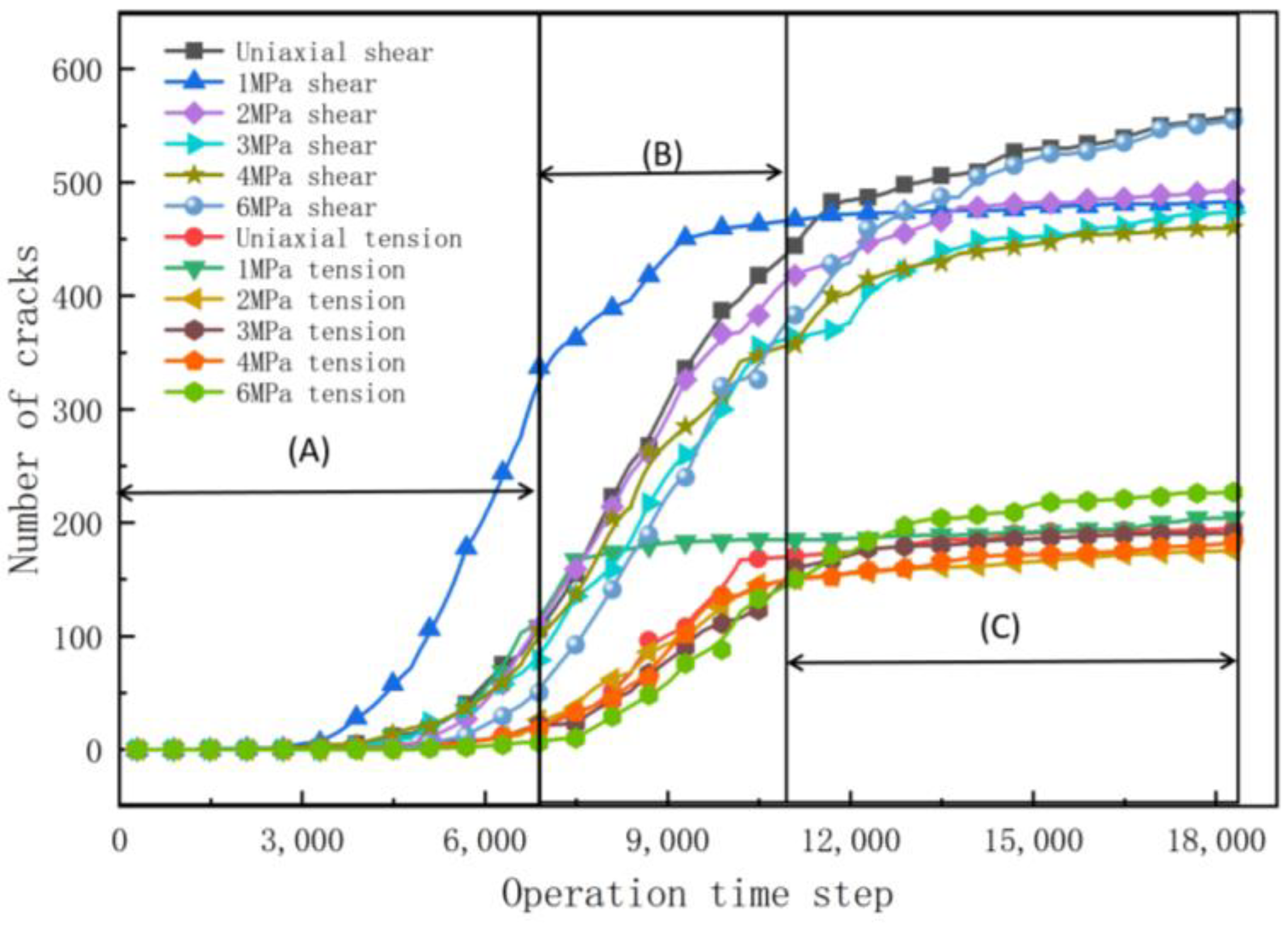

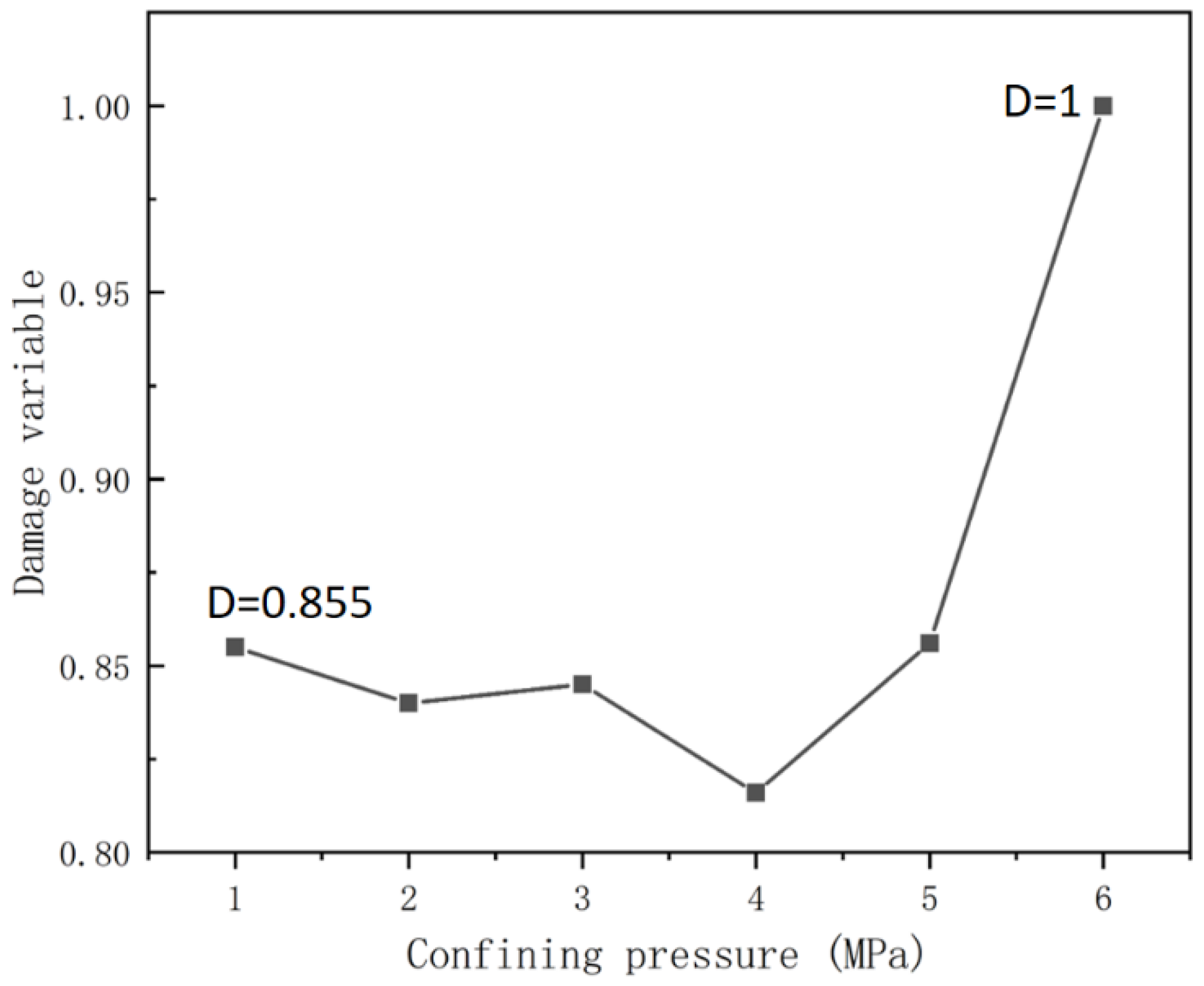

| Sandstone | Compressive Strength/MPa | Tensile Strength/MPa | Density (g/cm3) | Water Absorption (%) | Softening Coefficient | ||
|---|---|---|---|---|---|---|---|
| Natural State | Saturated State | Natural State | Saturated State | ||||
| S-1 | 14.13 | 3.69 | 1.04 | 1.04 | 2.2 | 9.94 | 0.19 |
| S-2 | 13.20 | 2.95 | 0.95 | 0.94 | 2.2 | 9.50 | 0.18 |
| S-3 | 14.58 | 3.30 | 0.94 | 0.94 | 2.2 | 9.32 | 0.18 |
| average | 13.97 | 3.31 | 0.97 | 0.97 | 2.2 | 9.58 | 0.18 |
| Parameter Name | /MPa | /GPa | Friction Angle φ/° | /MPa | /GPa | /GPa |
|---|---|---|---|---|---|---|
| value | 12.3 | 15.8 | 43 | 2.32 | 9.32 | 6.55 |
| Normal Stiffness | Tangential Stiffness | Internal Friction Angle | Cohesion | Tensile Strength | Permeability Factor | Residual Aperture | Initial Aperture |
|---|---|---|---|---|---|---|---|
| 100 GPa | 50 GPa | 30° | 0.5 MPa | 1.04 MPa | 83.3 | 1 × 10−6 m | 4 × 10−5 m |
Disclaimer/Publisher’s Note: The statements, opinions and data contained in all publications are solely those of the individual author(s) and contributor(s) and not of MDPI and/or the editor(s). MDPI and/or the editor(s) disclaim responsibility for any injury to people or property resulting from any ideas, methods, instructions or products referred to in the content. |
© 2023 by the authors. Licensee MDPI, Basel, Switzerland. This article is an open access article distributed under the terms and conditions of the Creative Commons Attribution (CC BY) license (https://creativecommons.org/licenses/by/4.0/).
Share and Cite
Zhen, W.; Liu, H.; Chi, M.; Liu, X.; Cao, W.; Chen, Z. Investigation into the Influence of Stress Conditions on the Permeability Characteristics of Weakly Cemented Sandstone. Appl. Sci. 2023, 13, 12105. https://doi.org/10.3390/app132212105
Zhen W, Liu H, Chi M, Liu X, Cao W, Chen Z. Investigation into the Influence of Stress Conditions on the Permeability Characteristics of Weakly Cemented Sandstone. Applied Sciences. 2023; 13(22):12105. https://doi.org/10.3390/app132212105
Chicago/Turabian StyleZhen, Wenyuan, Honglin Liu, Mingbo Chi, Xinyong Liu, Wenxiang Cao, and Zhiwen Chen. 2023. "Investigation into the Influence of Stress Conditions on the Permeability Characteristics of Weakly Cemented Sandstone" Applied Sciences 13, no. 22: 12105. https://doi.org/10.3390/app132212105
APA StyleZhen, W., Liu, H., Chi, M., Liu, X., Cao, W., & Chen, Z. (2023). Investigation into the Influence of Stress Conditions on the Permeability Characteristics of Weakly Cemented Sandstone. Applied Sciences, 13(22), 12105. https://doi.org/10.3390/app132212105







